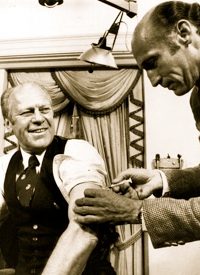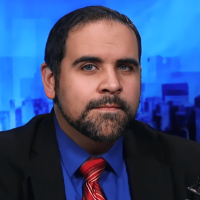
According to an article published by Global Security Newswire, deliberations within the Administration and the Department of Defense have been ongoing for several months, as the White House prepares its fiscal budget to present to Congress in February 2011.
It is not clear how the newly elected 112th Congress will respond to Obama’s budget request and transfer of funds. One thing that is clear, however, is the President’s commitment to expanding U.S. vaccine efforts, especially in the wake of the H1N1 scare last year. Fortunately, that scare did not manifest itself into as big a problem as was predicted by the government and was no more serious then the average flu.
According to a memo that was obtained by Global Security Newswire, compliance with President Obama’s new vaccine program “requires $1.07 billion” between fiscal years 2012 and 2016. More specifically, the memo cites that the following funds have been redirected: $1 billion from nuclear, biological and chemical defense programs, plus an additional $442 million reduction from Secretary of Defense Robert Gates, totaling to an estimated $1.5 billion for the vaccine initiative.
These defense cuts come in addition to the slight reduction of the military budget since Obama has taken office from $494.4 billion in 2008, under George W. Bush, to 494.3 billion in 2009, under Obama. Although the cuts may appear small in comparison to the overall defense budget, one government insider thinks otherwise.
A longtime defense analyst, who did not have permission to divulge details of the internal conversations between the White House and the DOD, and who also preferred to be unnamed, told Global Security Newswire: “By diverting $1 billion from nonmedical [chem-bio] defense programs to this medical vaccine facility on top of the OSD efficiency cuts, Mr. Weber threatens to return the military forces to a state of unpreparedness that we haven’t seen since 1996.”
Obama’s military spending cuts and focus on vaccination efforts is reminiscent to the days of President Gerald Ford when, for the first time in 30 years, U.S. military spending dropped to below $300 billion, going from 313.3 billion in 1973, under Richard Nixon, to 299.7 billion in 1974, under Ford, further declining to $283.8 billion by the end of his term in 1976/1977. 1976 also marked the year when in a special message to Congress, delivered on March 25, 1976, President Ford requested a “Special Supplemental Appropriation for the National Swine Flu Immunization Program.”
In that message to Congress, Ford made an urgent case, stating that, “The nation faces a serious potential public health threat this winter from a strain of virus known as swine influenza.” Ford went on to embellish his doomsday forecast by reminding the American people and Congress of the “very deadly flu epidemic late in 1918-19 … that 548,000 people died in this country during that tragic period — and 20 million worldwide.”
Ford increased the sense of urgency by stating: “Extraordinary measures are necessary because of the short time period available to assure adequate vaccine production and to mobilize the nation’s health care delivery system.” He went on to call for “an extensive immunization program” of a “full-scale operation” to be available within months.
Ford closed his speech with the following remarks: “I urge the Congress to act immediately to pass this special supplemental appropriation separately. This $135 million appropriation, if acted on promptly, will be a key factor in putting this threat behind us before next winter.”
Jumping ahead 30 years later to 2009, President Obama clamors to the trumpet of Ford declaring that the Swine Flu (H1N1) influenza is a national emergency. Then in his January 27, 2010, State of the Union Address, Obama told Congress, “we are launching a new initiative that will give us the capacity to respond faster and more effectively to bio-terrorism or an infectious disease, a plan that will counter threats at home and strengthen public health abroad.”
President Obama must agree with his predecessor Gerald Ford that “Extraordinary measures are necessary” if he is taking funds already allocated to WMD-defense for a vaccination program.
According to Global Security Newswire, Robin Robinson, director of the Department of Health and Human Services’ Biomedical Advanced Research and Development Authority, states that HHS will spend $478 million on building multiple “Centers for Innovation in Advanced Development and Manufacturing” facilities, which would be designated to alleviate small biotech firms in their efforts to “innovate new vaccines and field them more rapidly.”
The DOD will also be spending $200 million of its own money to build its own facility, in addition to those of HHS. The goal is to have 10-year-or-longer contracts signed with HHS and the DOD centers, which will be “operated by the respective contractor — perhaps a university consortium with a pharmaceutical firm,” according to Robinson.
Echoing what President Ford said in 1976, the Department of Health and Human Services has issued a report that states Swine Flu “vaccines were not broadly available before the virus had spread widely among the U.S. population.”
Ford’s call for a “full-scale operation” is essentially addressed in the HHS proposal for the construction of such facilities, which according to Global Security Newswire “would also be capable of large-scale production of vaccine stocks during a public health emergency” (Emphasis added). Such public health emergencies, according to the report, include “emerging infectious diseases or unknown threats, including pandemic influenza.”
The report goes on to define the government’s “envisioned result” as “an integrated, domestic infrastructure based on strategic partnerships with industry and/or academia with unprecedented flexible and modular capabilities to develop and manufacture new biological MCMs in a timely manner to protect the U.S. civilian population” (Emphasis added).
Historically, when the government uses the word “integrated,” that usually refers to an increase of government oversight and regulation in that field, which is certainly the case here as the government would be taking the lead in how to manufacture and implement such vaccinations, despite the involvement of private contractors.
The report goes on to list the “Initial Planned Objectives of the Centers” as follows:
• Provide surge vaccine production capacity for a response to any serious emerging disease threat for which a vaccine is available, including pandemic influenza;
• Provide advanced development and production of priority, selected CBRN MCMs;
• Provide additional capacity to manufacture clinical investigational lots of candidate vaccines, as well as manufacturing capacity to respond rapidly to emerging infectious disease outbreaks, including those involving previously unidentified microbes;
• Provide vaccine production capacity at pilot and/or commercial scale to augment the existing manufacturing infrastructure (e.g., small-market vaccines utilized by DOD, such as for adenovirus vaccine)
When President Ford signed the National Swine Flu Immunization Program on August 12, 1976, he expressed his “deep appreciation to the bipartisan leadership of both the House and the Senate,” which overwhelming voted in favor of the proposal. It should be noted that the 94th Congress, which passed the Immunization Program, was composed of Democratic majorities in both houses with a 61 filibuster-proof majority in the Senate and a 291-out-of-435-seat majority in the House.
The current Democratic majority 111th Congress is quite reminiscent of that Congress. However, come next year, with the 112th Congress, President Obama will likely face a totally different congressional makeup, given the popularity of the grassroots Tea Party movement that is poised to help Republicans score big wins in November.
In 1976, when Congress passed the Immunization Program, there were only two Nay votes cast in the House of Representatives, both of which were by medical doctors — Republican Rep. Ron Paul of Texas and Democratic Rep. Larry McDonald of Georgia, the latter of whom was then a member of the National Council of The John Birch Society.
Although President Ford did appreciate Paul’s and McDonald’s Nay votes, the American people were, of course, fortunate for their opposition, since the Swine Flu vaccines resulted in five hundred cases of Guillain–Barr syndrome and 25 deaths, much higher than the one death as a result of the Swine Flu. Looking back, the cure was unquestionably more deadly than the illness. The question now is whether Congress will make that same mistake come 2011.
Considering Ron Paul’s popularity and lack of a serious challenger for his reelection campaign, he will most likely be there to cast a Nay vote once again. Although Rep. McDonald will not be there to join Paul, the Tea Party is sure to give Dr. Paul some other like-minded friends in Congress to prevent the White House from going further ahead with its new vaccination initiative.
The news of this vaccination initiative comes in around the same time as the Centers for Disease Control (CDC) released a new study finding that the Swine Flu “Influenza killed an average 23,607 people each year in the last three decades, one-third fewer than the 36,000 estimate previously used to weigh the severity of a flu season,” as reported by Bloomberg.com .
Furthermore, regarding the severity of the Swine Flu cases, a new study published on September 8 in the Journal of American Medical Association found that “less than half as many children infected with the swine flu virus had to be hospitalized, compared to the corresponding number of children infected with seasonal flu strains of the previous years,” according to the Internationall Business Times.
The study was the first of its kind in directly comparing the number of cases of those reported to have contracted the H1N1 Swine Flu influenza compared to those who contracted other or regular influenza A strains, from 2009.
The International Business Times concludes that these findings are in line with those of the CDC, “indicating that that the swine flu was less deadly than one of the seasonal strains occurring in any other year.”
President Ford and the 94th Congress were wrong about the Swine Flu Influenza of 1976 and despite all the current information and data to the contrary today, President Obama seems poised to make the same clumsy slip-and-fall as Gerald Ford.
Photo: The "Vaccinee-in-Chief": U.S. President Gerald Ford rolls up his sleeve and receives a Swine Flu injection from White House physician, Dr. William Lukash, Oct. 14, 1976.




